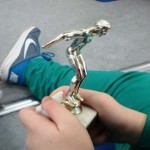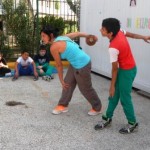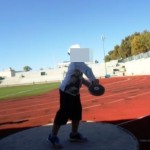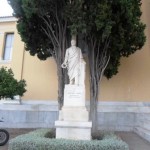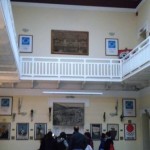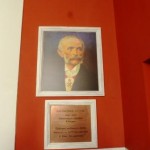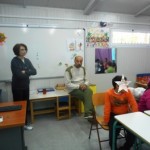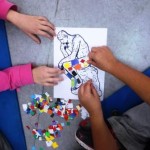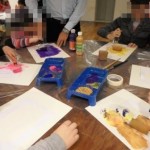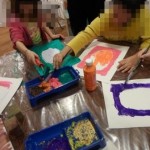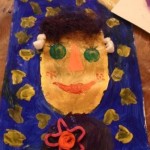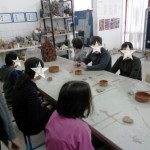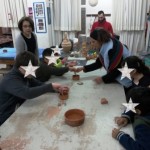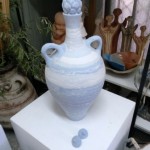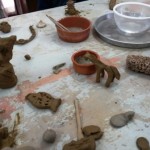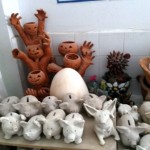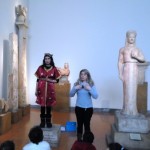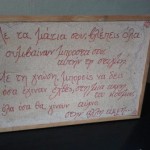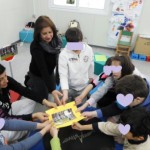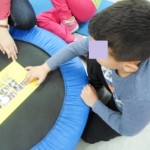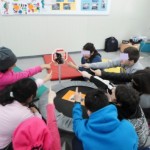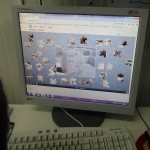The activities within e-Twinning program “You said sculpture?” are:
SEPTEMBER-OCTOBER 2015
1. The first contact of pupils with the art of Sculpturing and the “Discobolus” of Myron, who was an Ancient Greek Athenian sculptor, was made with a series of activities, which took place at the Physical Education classroom, in cooperation with our physical education teacher. Myron’s “Discobolus”, is the greek sculpture which was chosen from our school in order to be analyzed, in the context of the European e-Twinning program “You said Sculpture?”.
Thusly, photos of several sculptures were presented to the students, who touched actual sculptures made of different materials, created “Discobolous” made of plasticine and imitated his pose.
Teachers and pupils visited the open stadium of Korydallos’ Municipality, in order to throw the discus and experience Discobolous’ movement.
2. Aiming at familiarizing children with the Art of Sculpturing, there was an interdisciplinary approach in Language, History and Geography subjects. Students learned about the Cycladic Art, painted Cycladic idols and got familiar with ancient Greek sculptures and musical instruments. They also read texts regarding to Cycladic civilization, located and named the islands of Cyclades on the Greek map.
3. One more activity aiming at familiarizing children with the Art of Sculpturing, was a visit at the Panathenaic Stadium, the Zappeion and its gardens. Students had the opportunity to see and touch statues like Discobolous, Xylothrafsti and Eros and also to explore Zappeion Hall, see the famous frescoes, and walk to the Kallimarmaro!
NOVEMBER-DECEMBER 2015
4. As a part of the project activities, there was a Power Point Presentation of the countries participating at the program, photos of the respective school buildings and the sculpture that has been chosen to represent each country. This activity was aiming to make students familiar with the european countries participating in the program, learn about their cultures through the sculptures they had chosen and locate them in the european map. The aim of the activity was also to make students express their opinions and feelings imerging by the different sculptures.
5. Students and teachers at the Polish school worked on the Myron’s “Discobolus”, which was the greek choice of sculpture, in order to be analyzed, in the context of the European e-Twinning program “You said Sculpture?”. Thusly, our parters from Poland invited the famous Polish painter Barbara Retmaniak. She worked with the children on the greek statue, using their bodies, colours and a lot of imagination and the result was excellent! Thank you Poland!!
6. The students enjoyed an interesting activity and got familiar with the Arts of Sculpture and mosaics. Thusly, once more they expressed their creativity by making mosaics inspired by pictures of statues.
7. Visiting several museums is an integral part of the program in order to familiarize children with the Art of Sculpturing. Thus, a group of students visited the Cycladic Art Museum and participated in the workshop: The human form in ancient times. The initial aim of the museum is to be entertaining for the children who visit, while at the same time to involve them in a creative process in order to:
– Comprehend that there is no right or wrong in Art
– Learn that over the centuries people have used many different ways in order to illustrate the human form.
– Realize that Art is something vivid and evolves just like life. Times change, civilizations change, so the way we perceive the human form changes.
– See artworks and useful objects exhibited as a testimony of the distant past.
– Activate their imagination and learn through an interactive program.
– Create their own human form by using all the stimuli they have received.
JANUARY – MARCH 2016
8. One more activity within e-Twinning program “You said sculpture?” was the visit at the Pottery Workshop, which was organized by the City of Athens Culture, Sports & Youth Organization (OPANDA). A group of students had the opportunity to familiarize themselves with clay and create, with the valuable help of the person in charge of the workshop, inspired artwork, like animals, birds, flowers, peoples’ forms and ships made out of clay. the children were excited with the clay’s texture and plasticity and once again showed their artistic skills.
9. A group of students visited the National Archeological Museum and attended an educational program entitled “Reliving ancient Greek art”. The aims of the visit were:
- Familiarizing students with the Museum
- Familiarizing students with the Art of Sculpturing and particularly with statues of Kouroi (free-standing ancient Greek sculptures which first appear in the archaic period in Greece and represent nude male youths), Kore (the female sculptural counterpart of the kouros) and Zeus.
- Learning the history of Kore Phrasikleia (Φρασίκλεια).
The students participated in activities like:
– Observation, comparison and recognition of materials like marble, fabric etc.
– Representation of Phrasikleia and Kouros statues (drama play).
– Painting Phrasikleia statue.
10. As a part of the project activities, a group of students, with their teachers, visited the Tactual Museum in Athens. According to the information provided on the museum’s website, the Tactual Museum of Athens was founded in Athens in 1984 by the “Lighthouse of Visually Impaired people of Greece”, in order to give the opportunity to visually impaired people, to familiarize themselves with the cultural heritage of Greece. This is one of the four or five tactual museums in the world. The main difference between the Tactual Museum and other museums is that all visitors are allowed to touch the exhibits (statues, vessels, sculptures and useful artifacts), which are exact replicas of the originals displayed in the Museums of Greece, such as the National Archaeological museum, the Acropolis, Delphi, Olympia, Heraklion Museums and the Museum of Cycladic Art, dated back to the Cycladic, Minoan, Geometric, Archaic, Austere Rythm, Classical, Hellenistic and Roman periods. There are also exhibits from the Byzantine era and works of art from visually impaired people.
The children had the opportunity to touch and feel the exhibits (e.g. the sculptures of Aphrodite of Milos, Hermes of Praxiteles, Poseidon, Heniokhos/Charioteer of Delphi e.t.c.) and try to conceptualize the sculptures by touch. Through discussion with the responsible person of the program, students gained valuable knowledge concerning the exhibits and the Braille system. The use of masks during the educational games, helped them have a better understanding of the problems visually-impaired individuals encounter.
11. Our school’s students, completed the third scheduled activity within the e-Twinning program “You said sculpture?”. Their new task was to choose a statue from a partner-country and develop a related activity.
The selected activity was “making a puzzle” and aimed to the development of skills like observation, imagination, reasoning, spoken language and cooperation.
Thusly, the students, with their teachers’ discreet guidance, chose two statues of different countries and put the pieces of the puzzles together. The puzzles were showing the “The Thinker” statue (France) and “King Arthur and The Knights” statues (Poland).
Students, who attend the higher grade class, completed puzzles of all partner-countries’ statues on the computer. Both groups enjoyed the process a lot.
APRIL-MAY 2016
12. A group of pupils in our school liked the King Arthur’s Knights sculptures very much and they asked us to make a puzzle of them. First, teachers made the pieces, then we gathered in Physical Education class and started putting the pieces together. After we had finished, we took the glue and stuck the parts so as to post it on the class wall. We liked the team activity, it was pleasant and amusing.
13. In the following video you can watch beautiful moments from the implementation of our project. Hope you enjoy it!







